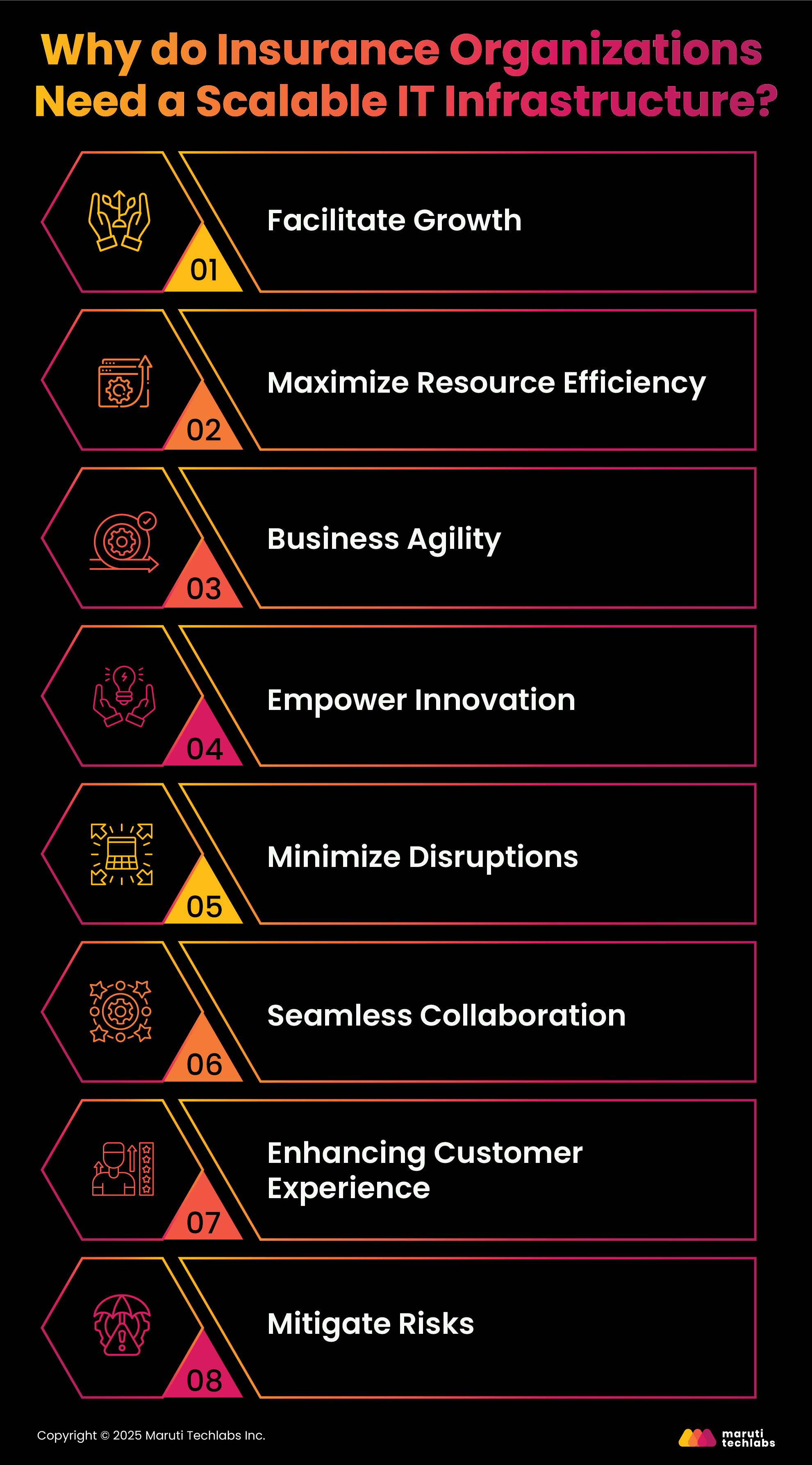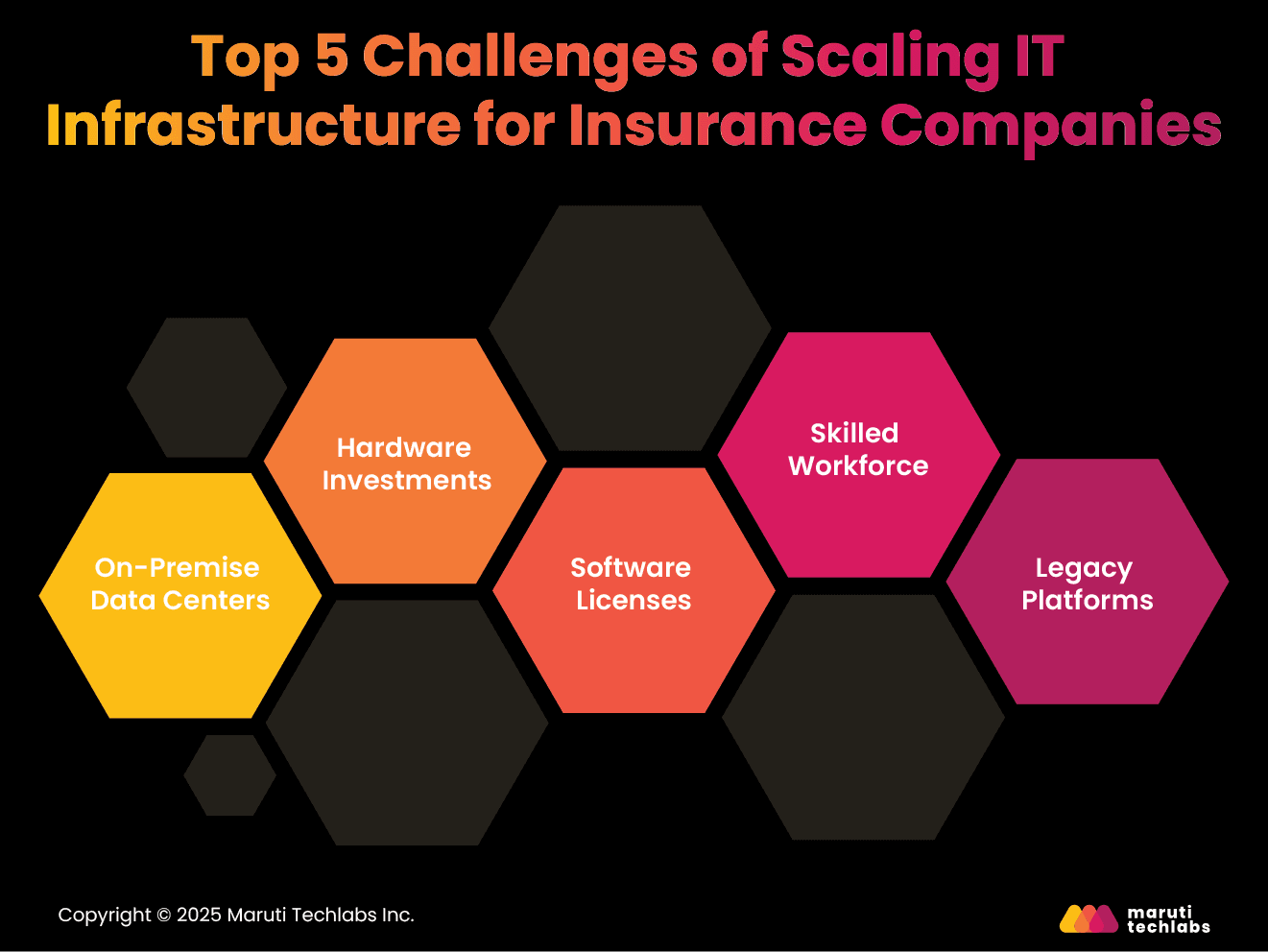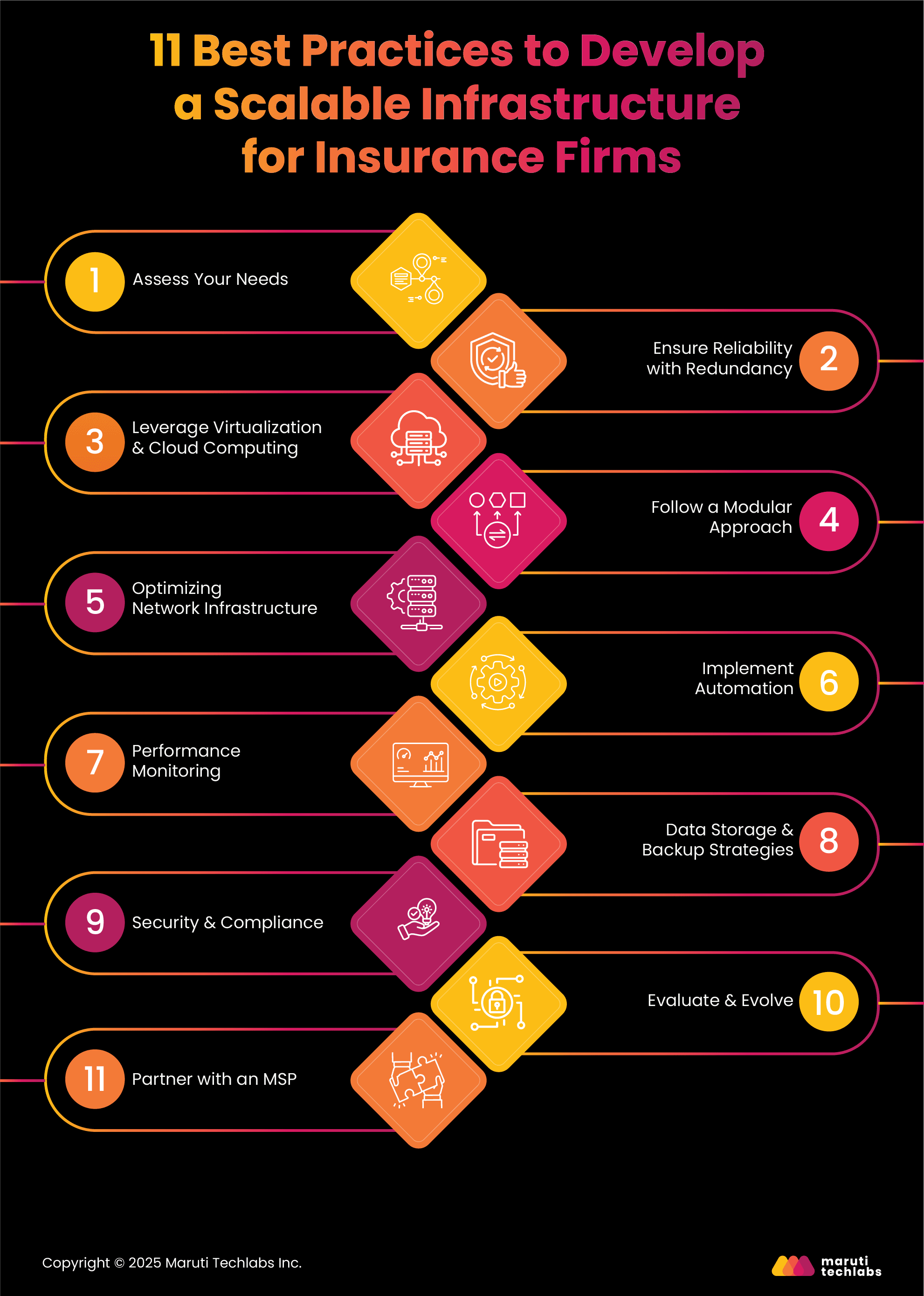

Introducing Scalability in Insurance: Challenges & Best Practices






Every business today relies on its IT infrastructure for daily operations. This holds true for the insurance industry as well. Though this transition has been slow, the competitive landscape is making it necessary for insurance companies to embrace digitization.
However, one of the primary requirements for embracing digitization is having a scalable IT infrastructure. Scalability can be introduced in two major forms: first, with an on-premise hardware setup, where one has to manage both hardware and software and their peripheral operations.
The second and more viable option is cloud computing. Cloud adoption in insurance presents a digital-first approach, which is exactly what is needed today. It delivers more value than an on-prem infrastructure, barring the hassle of continual maintenance and hiring operational overheads.
This blog offers crucial insights on the importance of scalability for insurance companies, its challenges, and the best practices you can leverage to plan or improve scalability with your insurance IT infrastructure.
A scalable IT infrastructure in insurance concerns its capability to expand or shrink dynamically based on changing demands. This convenience is crucial for insurance companies handling variable workloads while ensuring optimal performance and cost savings.
Imagine your business's IT infrastructure as a goods train. On a typical day, you might need X carriages to transport the goods. However, on some days, you might have more or fewer goods to transport, changing the resources you need for transportation.
Here are the different types of scaling that one can implement to address varying infrastructure needs.
Vertical scaling increases a server's capability of handling more load by adding more processing power or storage units, such as CPUs, RAMs, or SSDs. It's easier to execute as it only requires adding a unit to a server.
However, this only works for temporary spikes and is limited to the size of your server. Once your server reaches its maximum capacity, it can't be scaled further.
Compared to adding more units to a server, horizontal scaling adds more servers to a database. It's worth the investment if you observe regular spikes in traffic. However, implementing this is more complex than vertical scaling, as each server must be connected to the network.
Additionally, it needs more resources, power, security, and workforce to maintain.
Scalability is the key aspect when transitioning to the cloud. Businesses opt for two prominent types of cloud scaling: public and private clouds.
With Public clouds, the providers manage the scaling. However, the organization must decide on its technical aspects, like scope and size. In private clouds, the organization is responsible for hardware and software changes. They have the autonomy to choose between horizontal and vertical scaling.
Here are the top 8 reasons insurance companies should have a scalable IT infrastructure.
As insurance companies observe an increase in their customer base, their IT infrastructure should be able to manage the workload. A scalable infrastructure ensures that the performance and user experience remain uncompromised. It allows organizations to continue offering high-level services.
A scalable infrastructure encourages dynamic resource allocation. It provides scalability when required instead of overprovisioning resources. This reduces costs, minimizes waste, and enhances operational efficiency.

Insurance companies' adaptability sets them apart from their competitors. A scalable IT infrastructure offers the convenience of transitioning to emerging technologies and meeting evolving customer needs. In addition, it imbues confidence while exploring new markets, launching new products, or switching strategies without worrying about a limited infrastructure.
Scalability allows organizations to experiment with technologies like artificial intelligence, machine learning, big data, and IoT. It fosters a culture of innovation where organizations can try new ideas, create proof of concepts, and scale effectively.
A scalable infrastructure allows businesses to have backup systems to facilitate operations during system failures or disruptions. It also ensures that critical products or services are accessible and functional, supporting business continuity. Integrating failover mechanisms and load balancing sets the stage for a resilient IT infrastructure.
The digital transformation in insurance has given rise to remote work powered by efficient collaboration tools. Scalable infrastructure allows organizations to support virtual workplaces and collaboration platforms, ensuring complete synchronization across different locations and time zones. It gives an edge to businesses with the flexibility of staying connected and productive from anywhere.
An insurance organization's capability to deliver a consistent user experience with fast websites or applications directly affects its engagement rate. Users demand seamless services even during peak usage, and the only way to meet these expectations is with a scalable IT infrastructure.
A scalable infrastructure offers opportunities to implement robust security measures like intrusion detection systems, firewalls, and encryption protocols. Additionally, it ensures critical data and systems are secure and recoverable using disaster recovery and backup strategies.
The technology employees use greatly influences their experience of their employer's workplace. Insurance companies that embrace digital transformations inculcate a seamless, engaging, and efficient workplace culture. On the other hand, organizations that use legacy or slow, outdated systems lead to lower productivity and job satisfaction.
Today, technologies like Infrastructure as Code (IaC) and cloud computing in insurance offer new opportunities for rapid and agile innovation. However, it's difficult for organizations to switch from traditional systems to the cloud.
Why? Transitioning from long-term commercial contracts to the cloud can be costly and complex. In addition, if a business doesn't adapt to new processes and lacks a skilled workforce, it can face operational inefficiencies, and its performance can actually deteriorate.
Companies need an IT infrastructure overhaul to extract maximum benefits from their cloud investments. Here are the most common challenges they need to address.
Insurance organizations may have invested in long-term and costly commitments to owning, maintaining, and managing their own data centers. However, this traditional practice may not align with sustainability goals and evolving business needs.
Investments in assets purchased over a 3-5 year depreciation period or on leases occupy the budget that can be used for transitioning to the cloud.
Many insurance firms spend almost half their budget on software, some of which is not worth the investment, especially with siloed organizations.

Insurance companies have been slow to adapt to technological reforms. However, they do invest in training and certifications for their employees. The switch to digitization has increased the struggle for many to stay competitive and relevant.
COBOL, CISC, and DB2, which once were the only options for large-scale processing needs, are still powering many companies' most critical transactions. However, these systems need significant modernization to meet today's business and technological demands.
Here is a list of 11 proven tactics you can leverage to plan your IT infrastructure transition.

The primary step before making any investment or commitment is a thorough evaluation of your current and future IT needs. You can start by monitoring your insurance company's growth over the past year. This will help you visualize the actuality of the upgrade required and assist you with understanding workload, budget prediction, and developing a roadmap.
Downtime can have dire consequences, enhancing the importance of redundancy and availability. Therefore, it's extremely important to distribute workloads, ensure failover capabilities, and minimize disruptions using load balancers, clustering, and fault-tolerant architectures. To develop an architecture ready for any challenge, you have to foresee everything that can go wrong.
Using virtualization and cloud computing helps you attend to your evolving business needs of any magnitude. Virtualization with virtual machines (VMs) and containers allows you to optimize hardware and increase efficiency. You can unlock the cloud's on-demand capabilities using Infrastructure-as-a-Service (IaaS) and Platform-as-a-Service (PaaS). Embracing these technologies helps your business stay agile and cost-effective.
Scalability yields the best results following a modular approach. This approach allows each component to function independently with seamless integration. Businesses can scale individual elements without disrupting the system using microservices, containers, and API-driven architectures. This offers a high level of flexibility, enabling continuous innovation and long-term growth.
Your IT infrastructure ties numerous departments of your organization together. You need a robust infrastructure to ensure strong communication, data exchange, and collaboration. Unpredictable spikes in traffic require high-performance switches, routers, and firewalls. In addition, to optimize security, performance, and control, you must implement network segmentation, virtual LANs (VLANs), and software-defined networking (SDN). Your systems will perform at their best with an upfront investment in network infrastructure.
You can leverage automation to introduce rapid scalability, improve efficiency, and automate repetitive tasks. You can automate your infrastructure's provisioning, configuration, and management by implementing Infrastructure-as-a-Code practices (IaC), orchestration frameworks, and configuration management tools. This helps you observe an evident decrease in human efforts, ensure consistency, and simplify scalability.
Effective performance monitoring and optimization result in seamless scalability and efficiency. Businesses today can track metrics like CPU usage, memory utilization, network traffic, and application response time by implementing monitoring and logging solutions. These insights help with proactive issue resolution, resource allocation, and enhanced performance.
You need scalable data storage and backup strategies to ensure business continuity and address growing data needs. You can implement this using horizontal scaling that uses distributed storage systems, like distributed file systems or object storage, for expanding data volumes. This is an essential feat to shield your important assets from being compromised.
Security and compliance protect data, systems, and operations from evolving threats and are critical pillars of a scalable IT infrastructure. To safeguard your environment, you can use firewalls, intrusion detection systems, and encryption protocols. It’s also essential to comply with industry data protection standards. This can be done by performing timely audits and assessments.
Developing a scalable infrastructure is a continuous process that doesn't end once you establish this change. You have to be on a continual learning curve, collecting feedback from users and stakeholders. In addition, you have to stay updated with emerging technologies and industry trends. Each iteration takes you a step closer to your infrastructure's evolution.
Partnering with a Managed Service Provider (MSP) enhances IT operations by providing expertise, proactive support, and cost savings. MSPs manage complex tasks, optimize infrastructure, and free internal teams to focus on core business goals, ensuring seamless scalability and improved efficiency.
A scalable IT infrastructure is a necessity. It offers ample benefits, such as facilitating growth, business agility, seamless collaboration, and enhanced customer experiences.
We at Maruti Techlabs helped our insurance client, Medigap Life, overcome performance challenges in their vTiger CRM. The system struggled with large data volumes due to rigid workflows, sequential processing, and excessive interdependencies—leading to slow performance, long processing times, and inefficiencies in customer engagement and marketing operations.
Maruti Techlabs optimized Medigap Life's CRM workflows, reducing SMS campaign execution time by 87.5% and shortening customer acquisition and retention campaigns from 8 hours to 1 hour, thereby enhancing operational efficiency and decision-making.
Understanding that unexamined and unplanned investments in scaling your IT infrastructure can do more harm than good is imperative. They can disrupt your business operations, cause reputational damage, and result in budget overruns.
This is where we come in. Having more than 14+ years of experience with Cloud Migration Consulting, we offer end-to-end cloud assessments in just 2-weeks. Our expert business technology consultants assess your niche requirements, current infrastructure, and suggest long-term sustainable solutions. Connect with us today to evaluate your IT infrastructure and how you can introduce enhancements to build a future-ready, high-performance, and cost-effective IT ecosystem.


